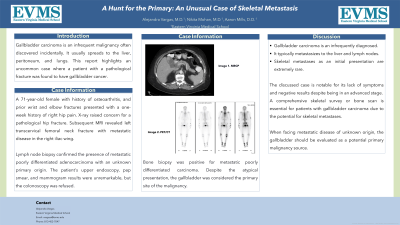Tuesday Poster Session
Category: Biliary/Pancreas
P2925 - A Hunt for the Primary: An Unusual Case of Skeletal Metastasis
Tuesday, October 24, 2023
10:30 AM - 4:00 PM PT
Location: Exhibit Hall

Has Audio

Alejandra Vargas, MD
Eastern Virginia Medical School
Norfolk, VA
Presenting Author(s)
Alejandra Vargas, MD, Nikita Mohan, MD, Aaron Mills, DO
Eastern Virginia Medical School, Norfolk, VA
Introduction: Gallbladder carcinoma is an infrequent malignancy often discovered incidentally as it is generally asymptomatic in its early stages. While gallbladder carcinoma has been known to metastasize to various regions, including the liver, peritoneum and lungs, bone involvement is a rare occurrence. This report details a case of a patient who presented with a pathological fracture, subsequently discovered to have a gallbladder cancer.
Case Description/Methods: A 71-year-old female with history of osteoarthritis, and prior wrist and elbow fractures presented to the emergency room with a one-week history of right hip pain, prompting an initial X-ray that raised concern for a pathological hip fracture. Magnetic resonance imaging revealed left transcervical femoral neck fracture with a suspicious lesion in the femoral head-neck junction and metastatic disease in the right iliac wing. Despite the lack of significant clinical symptoms beyond hip pain and negative laboratory values including tumor markers, further imaging studies were performed.
The imaging studies revealed a region of enhancement in the gallbladder fundus, enlarged portacaval and periaortic lymph nodes. A computed tomography guided lymph node biopsy confirmed the presence of metastatic poorly differentiated adenocarcinoma with an unknown primary origin. The patient's upper endoscopy, pap smear, and mammogram results were unremarkable, but the colonoscopy was refused. A magnetic resonance cholangiopancreatography revealed an enhancing mass in the gallbladder fundus, and retroperitoneal adenopathy. Further testing with a bone survey did not show any additional lytic focus and bone biopsy was positive for metastatic poorly differentiated carcinoma. Despite the atypical presentation, the gallbladder was considered the primary site of the malignancy based on the imaging and pathology report.
Discussion: Gallbladder carcinoma is a rare malignancy that is often incidentally discovered. While it commonly metastasizes to the liver and lymph nodes, initial presentation with skeletal metastases is exceedingly rare. The case presented here is remarkable for the absence of symptoms and negative workup despite advanced stage. A comprehensive skeletal survey or bone scan is essential for patients with gallbladder carcinoma due to the potential for skeletal metastases. Moreover, in cases of suspected metastatic disease of unknown origin, the gallbladder should be considered a potential primary source of malignancy.
Disclosures:
Alejandra Vargas, MD, Nikita Mohan, MD, Aaron Mills, DO. P2925 - A Hunt for the Primary: An Unusual Case of Skeletal Metastasis, ACG 2023 Annual Scientific Meeting Abstracts. Vancouver, BC, Canada: American College of Gastroenterology.
Eastern Virginia Medical School, Norfolk, VA
Introduction: Gallbladder carcinoma is an infrequent malignancy often discovered incidentally as it is generally asymptomatic in its early stages. While gallbladder carcinoma has been known to metastasize to various regions, including the liver, peritoneum and lungs, bone involvement is a rare occurrence. This report details a case of a patient who presented with a pathological fracture, subsequently discovered to have a gallbladder cancer.
Case Description/Methods: A 71-year-old female with history of osteoarthritis, and prior wrist and elbow fractures presented to the emergency room with a one-week history of right hip pain, prompting an initial X-ray that raised concern for a pathological hip fracture. Magnetic resonance imaging revealed left transcervical femoral neck fracture with a suspicious lesion in the femoral head-neck junction and metastatic disease in the right iliac wing. Despite the lack of significant clinical symptoms beyond hip pain and negative laboratory values including tumor markers, further imaging studies were performed.
The imaging studies revealed a region of enhancement in the gallbladder fundus, enlarged portacaval and periaortic lymph nodes. A computed tomography guided lymph node biopsy confirmed the presence of metastatic poorly differentiated adenocarcinoma with an unknown primary origin. The patient's upper endoscopy, pap smear, and mammogram results were unremarkable, but the colonoscopy was refused. A magnetic resonance cholangiopancreatography revealed an enhancing mass in the gallbladder fundus, and retroperitoneal adenopathy. Further testing with a bone survey did not show any additional lytic focus and bone biopsy was positive for metastatic poorly differentiated carcinoma. Despite the atypical presentation, the gallbladder was considered the primary site of the malignancy based on the imaging and pathology report.
Discussion: Gallbladder carcinoma is a rare malignancy that is often incidentally discovered. While it commonly metastasizes to the liver and lymph nodes, initial presentation with skeletal metastases is exceedingly rare. The case presented here is remarkable for the absence of symptoms and negative workup despite advanced stage. A comprehensive skeletal survey or bone scan is essential for patients with gallbladder carcinoma due to the potential for skeletal metastases. Moreover, in cases of suspected metastatic disease of unknown origin, the gallbladder should be considered a potential primary source of malignancy.
Disclosures:
Alejandra Vargas indicated no relevant financial relationships.
Nikita Mohan indicated no relevant financial relationships.
Aaron Mills indicated no relevant financial relationships.
Alejandra Vargas, MD, Nikita Mohan, MD, Aaron Mills, DO. P2925 - A Hunt for the Primary: An Unusual Case of Skeletal Metastasis, ACG 2023 Annual Scientific Meeting Abstracts. Vancouver, BC, Canada: American College of Gastroenterology.
